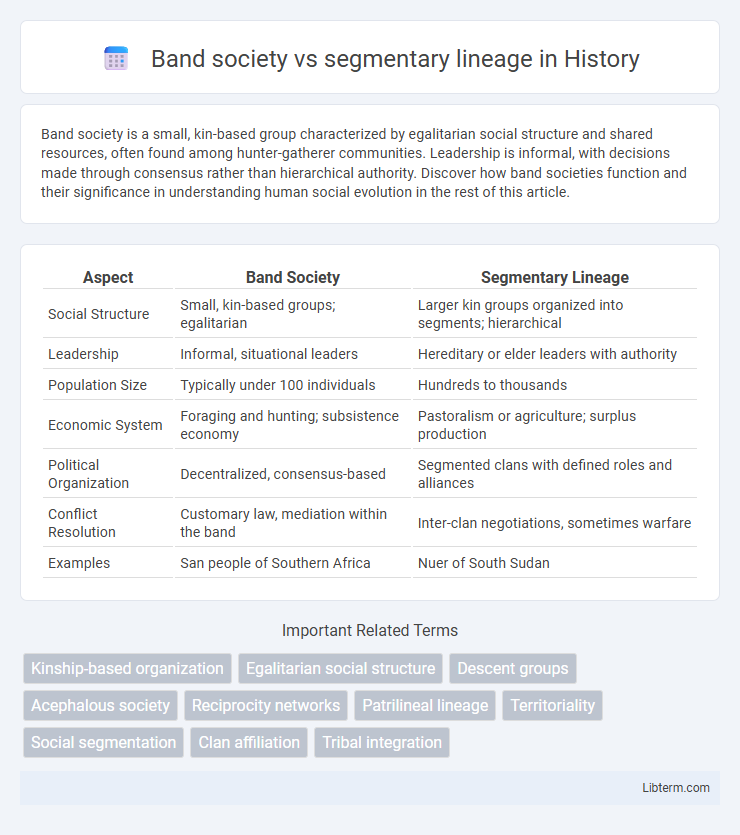Band society is a small, kin-based group characterized by egalitarian social structure and shared resources, often found among hunter-gatherer communities. Leadership is informal, with decisions made through consensus rather than hierarchical authority. Discover how band societies function and their significance in understanding human social evolution in the rest of this article.
Table of Comparison
| Aspect | Band Society | Segmentary Lineage |
|---|---|---|
| Social Structure | Small, kin-based groups; egalitarian | Larger kin groups organized into segments; hierarchical |
| Leadership | Informal, situational leaders | Hereditary or elder leaders with authority |
| Population Size | Typically under 100 individuals | Hundreds to thousands |
| Economic System | Foraging and hunting; subsistence economy | Pastoralism or agriculture; surplus production |
| Political Organization | Decentralized, consensus-based | Segmented clans with defined roles and alliances |
| Conflict Resolution | Customary law, mediation within the band | Inter-clan negotiations, sometimes warfare |
| Examples | San people of Southern Africa | Nuer of South Sudan |
Introduction to Band Society and Segmentary Lineage
Band societies represent the simplest form of human social organization, typically consisting of small, kin-based groups with egalitarian structures and minimal hierarchy. In contrast, segmentary lineage societies are characterized by descent-based groups organized into segments or clans, where social cohesion and political authority are maintained through kinship ties and lineage alliances. Both social systems illustrate distinct strategies for managing social relationships, resource distribution, and conflict resolution in pre-state and stateless communities.
Definition and Key Features of Band Society
Band society refers to small, kin-based groups typically of fewer than 100 individuals who rely on hunting and gathering for subsistence, characterized by egalitarian social structures and fluid membership. Key features include decentralized leadership with decisions made through consensus, absence of formal institutions, and strong kinship ties governing social cohesion and resource sharing. Unlike segmentary lineage systems, band societies lack complex hierarchical organization and segmentary political structures.
Characteristics of Segmentary Lineage Systems
Segmentary lineage systems are characterized by the organization of society into clans or lineages that trace descent from a common ancestor, forming nested groups with defined kinship ties. These systems emphasize segmental divisions where each lineage operates autonomously but unites with allied segments during conflicts or collective decision-making. Leadership in segmentary lineage societies is often situational, based on consensus and seniority within the lineage, contrasting the more egalitarian and fluid social structure of band societies.
Social Organization and Structure
Band societies exhibit a minimal social organization characterized by small, kin-based groups with informal leadership and egalitarian decision-making. Segmentary lineage systems display a more complex structure, organized around extended kinship lineages that unite or divide based on social or political needs, often resulting in hierarchical alliances. These differences reflect varying mechanisms for social control, cohesion, and conflict resolution rooted in subsistence strategies and population size.
Leadership and Decision-Making Processes
Band societies operate through informal leadership with decisions made collectively by consensus among adult members, emphasizing egalitarian principles and shared responsibility. In contrast, segmentary lineage societies exhibit formalized leadership within kinship groups where authority often derives from lineage elders, and decision-making follows hierarchical structures rooted in familial ties. Leadership in segmentary lineages functions to mediate conflicts and coordinate group actions, reflecting the importance of ancestry and social stratification in governance.
Kinship and Social Ties Comparison
Band societies rely on kinship ties based on immediate family and close relatives, fostering egalitarian social structures with flexible and informal leadership. Segmentary lineage systems organize individuals into descent groups tracing common ancestors, creating formalized kinship clans that regulate social cohesion and conflict resolution through hierarchical segment divisions. Social ties in band societies emphasize personal relationships and communal sharing, while segmentary lineage systems prioritize collective identity and political alliances within lineage segments.
Economic Practices and Resource Management
Band societies practice a foraging economy based on shared ownership and collective decision-making, emphasizing resource sharing to ensure survival in small-scale, mobile groups. Segmentary lineage societies utilize kinship-based segments to organize labor and resource distribution, often engaging in pastoralism or horticulture with coordinated management of communal land and water resources. Both systems adapt their economic practices to environmental constraints, but segmentary lineages demonstrate more structured resource control through lineage hierarchy.
Conflict Resolution and Social Control
Band societies maintain social control through informal mechanisms like kinship ties and consensus decision-making, which facilitate conflict resolution by emphasizing cooperation and avoidance of direct confrontation. Segmentary lineage systems employ structured kin-based segments that mobilize collective support during disputes, enforcing social norms through hierarchical loyalty and reciprocal responsibilities. Both frameworks rely on social cohesion but differ in organizational complexity and the scale of conflict management strategies.
Case Studies and Ethnographic Examples
Band societies, exemplified by the San people of Southern Africa, rely on small, kin-based groups with flexible social organization and egalitarian decision-making, facilitating mobility and resource sharing in hunter-gatherer contexts. Segmentary lineage systems, illustrated by the Nuer of South Sudan, organize society around patrilineal clans that mobilize collectively for defense and conflict resolution, emphasizing segmental kinship structures in pastoralist environments. Ethnographic studies highlight how these distinct social frameworks address environmental challenges and social cohesion, with band societies favoring fluid alliances and segmentary lineages enforcing structured kin alliances.
Conclusion: Key Differences and Similarities
Band societies operate as small, kin-based groups with minimal social stratification, relying on egalitarian decision-making and informal leadership. Segmentary lineage systems organize larger populations into hierarchical clans and sub-clans, emphasizing kinship ties for political alliances and conflict resolution. Both systems prioritize familial relationships and demonstrate adaptive social organization, but differ significantly in scale, complexity, and formal authority structures.
Band society Infographic

 libterm.com
libterm.com